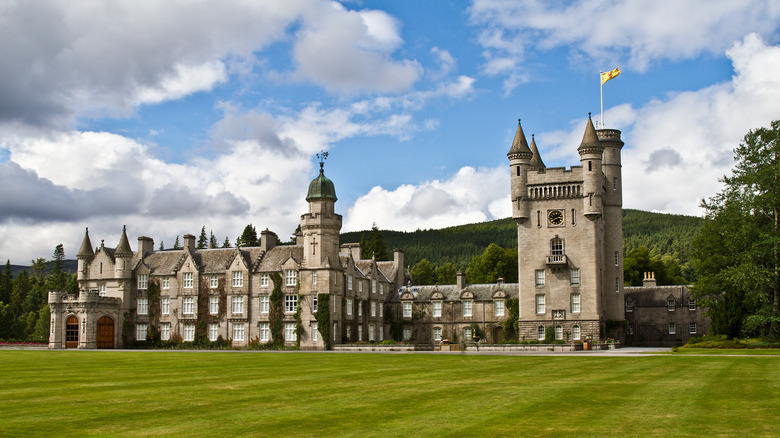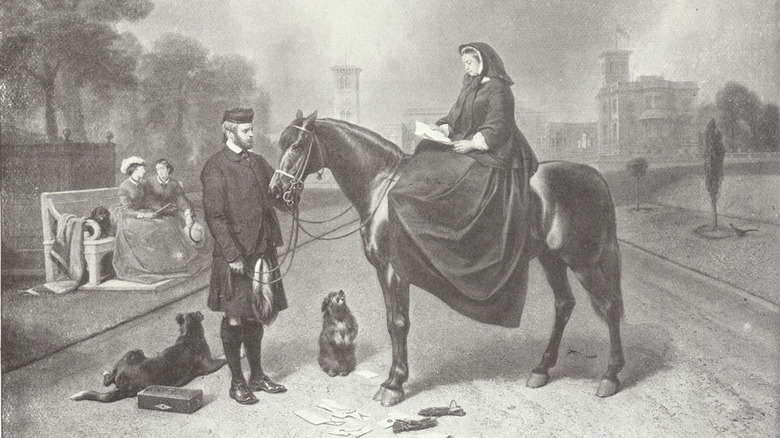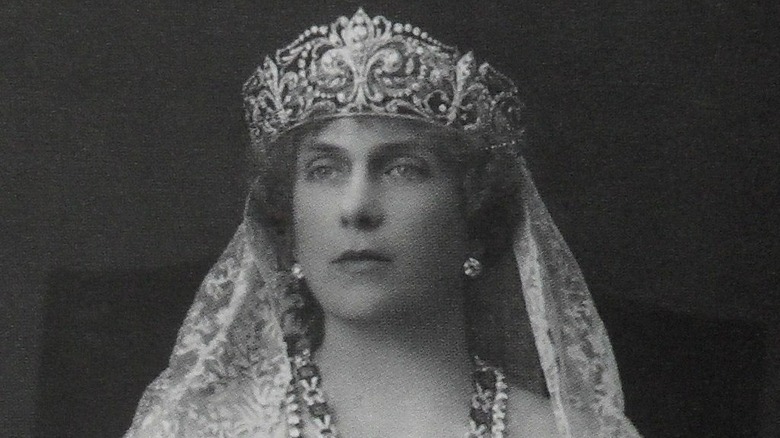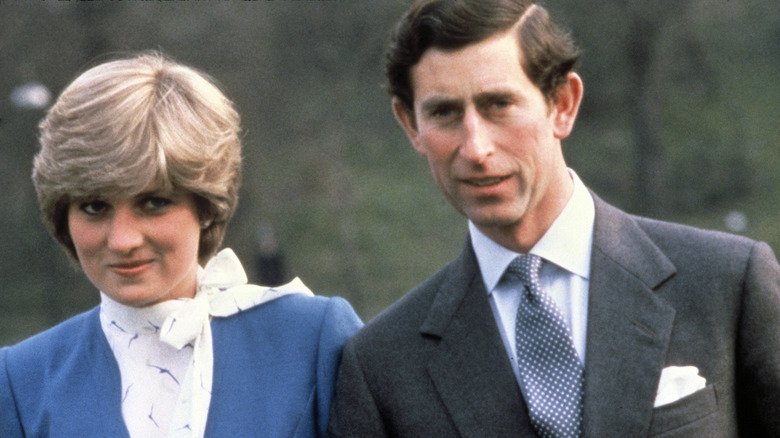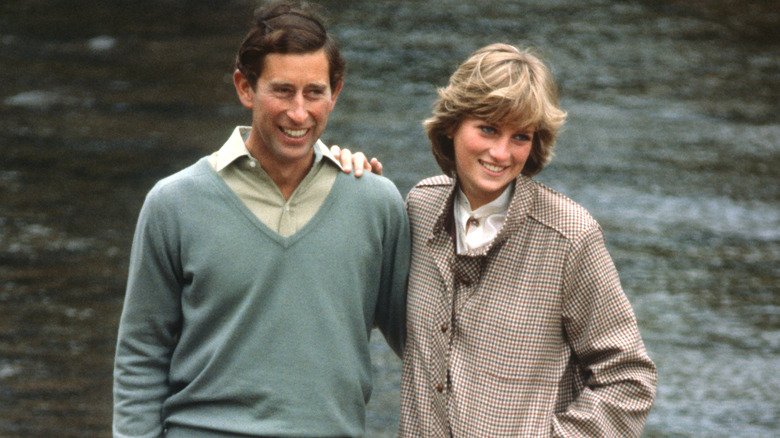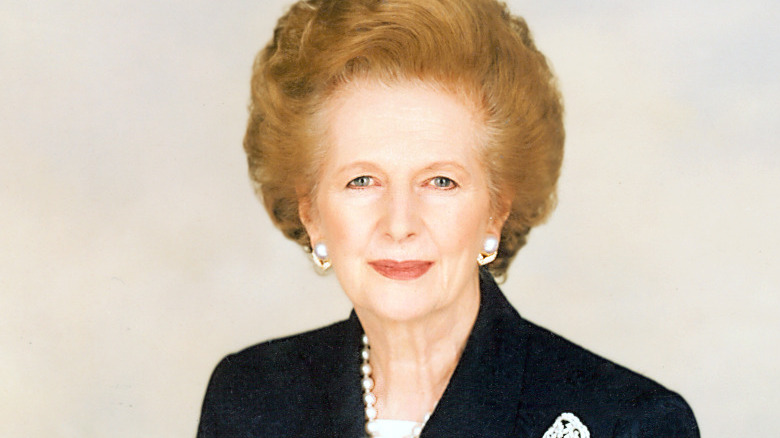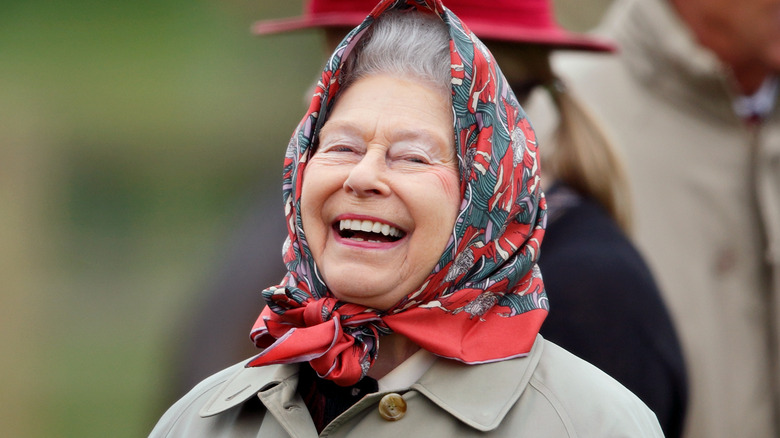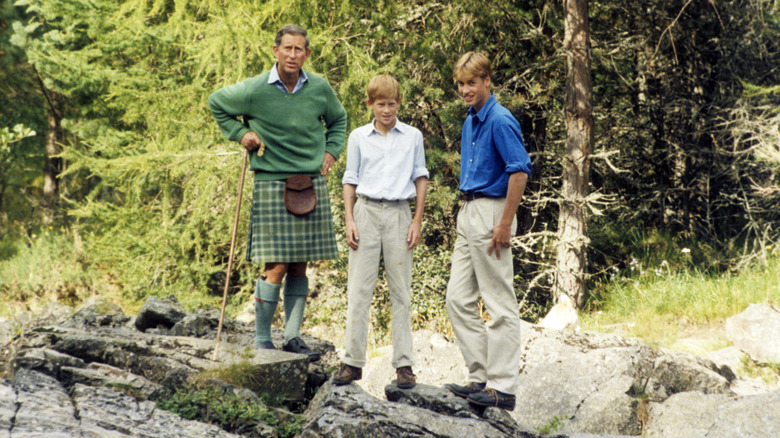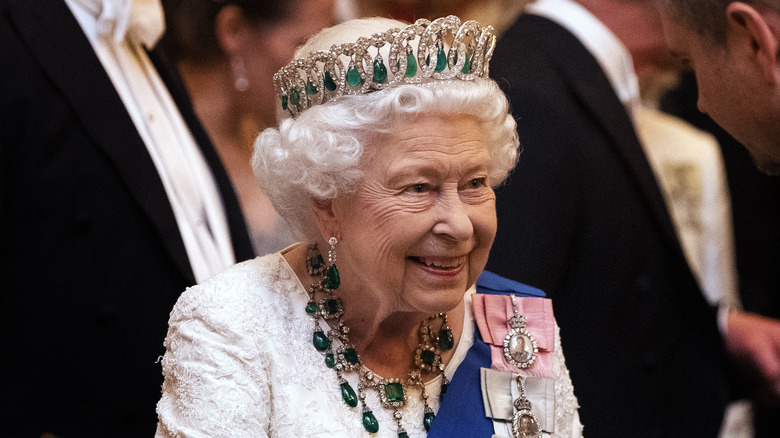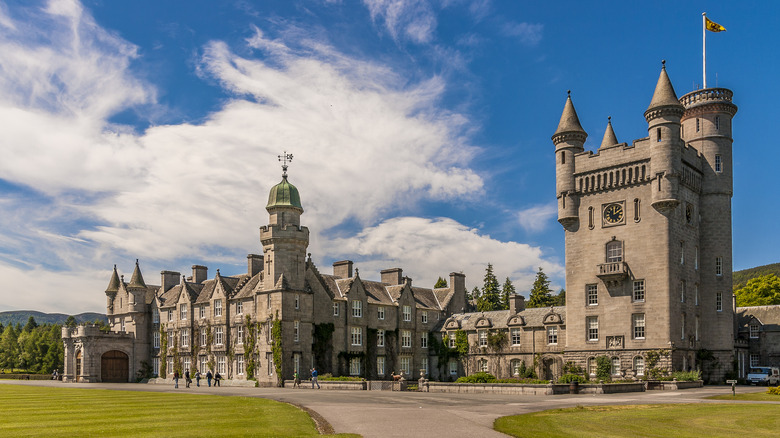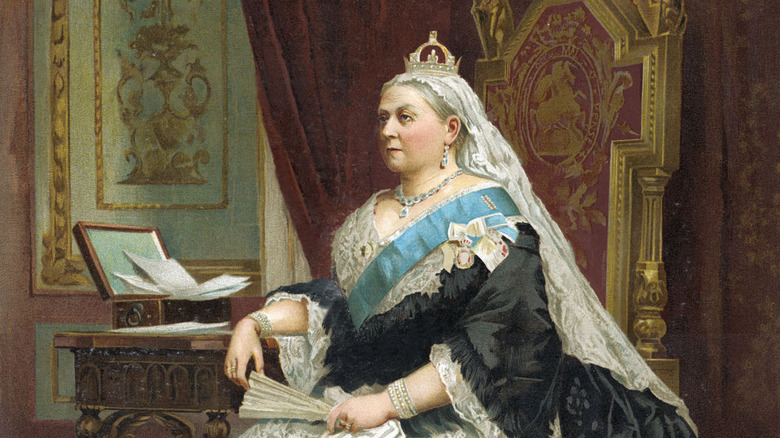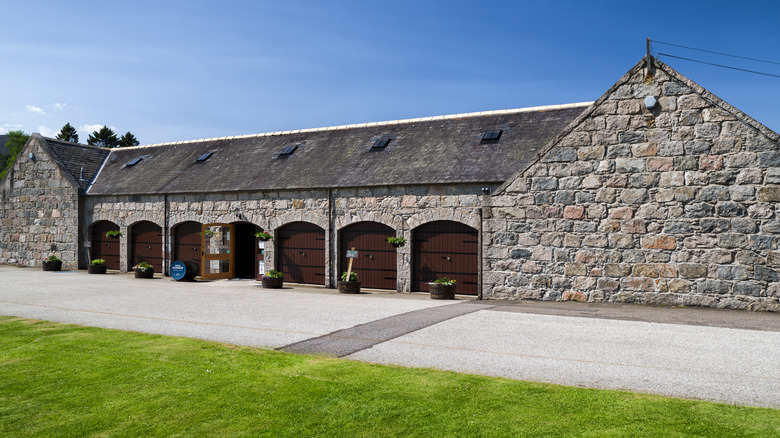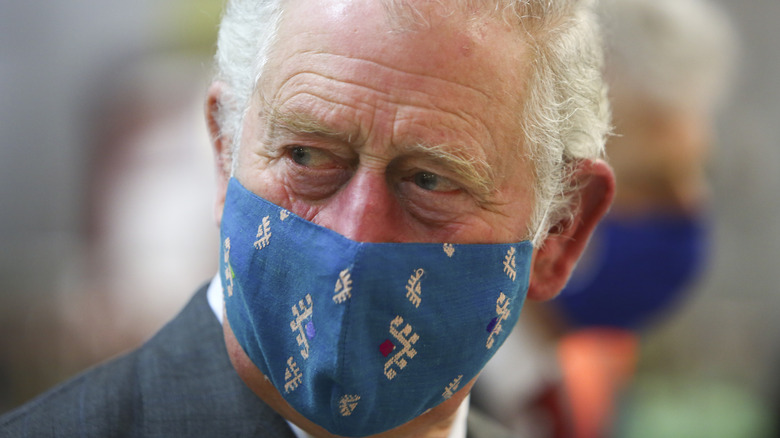The Untold Truth Of Balmoral Castle
In 1852, Queen Victoria and Prince Albert, enchanted by Scotland, decided to purchase the Balmoral estate. The palace, which is located in Royal Deeside, Aberdeenshire, has since been handed down through the generations and is currently in the possession of Queen Elizabeth II, according to House & Garden. The royal family's retreat is huge. It features 50,000 acres of gardens, forests, mountains, and pastures. In addition, 150 buildings are part of the estate, including Prince Charles' house at Birkhall.
Family members frequently fish and hunt on the property, which is also a popular place for them to host picnics and barbecues. Balmoral is also open to the public, so visitors can get a taste of royal life. It was closed in 2020 due to the COVID-19 pandemic, but tourists can once again explore the grounds, gardens, and exhibitions, according to the estate's official webpage. However, tourists are only allowed to visit the ballroom in the castle because the rest is part of the queen's private residence, notes Hello! Magazine. If you plan on visiting the castle, you can have a meal at the Balmoral Restaurant, enjoy morning coffee and cake, or partake in afternoon tea. You may also be interested in renting one of the estate's holiday cottages or playing a round of golf.
Balmoral has a rich history with some interesting stories involving its past and current occupants. Check out some of the fascinating history of this famous royal retreat below.
Queen Victoria had a special relationship with a Balmoral servant after Prince Albert died
Queen Victoria and Prince Albert picked Deeside for their holiday getaway because the weather was allegedly more pleasant in that area of the country compared to other locations, according to the BBC. They initially leased Balmoral before eventually buying it. Scotsman John Brown started working on the estate in 1848, when he was 21 years old, The Sunday Post reports, and his presence would make a big impact on the queen.
In the book "Victoria – The Queen," author Julia Baird noted (via The Sunday Post) that Victoria considered Brown to be an "invaluable Highland servant." The pair grew particularly close following Albert's death in 1863. Brown was eventually promoted to queen's Highland servant and then John Brown, Esquire. In diary excerpts, Victoria described Brown as having a "strong, powerful arm" and recounted her riding adventures with him with gusto.
In time, rumors persisted that the pair may have been more than just friends, according to History of Royal Women. Brown was definitely favored by the queen, as she raised his salary, gave him several awards, and gifted him a house for retirement. He spent nearly two decades in her service, and when he died, Victoria was devastated. Among John's brother Hugh Brown's possessions following his death was a diary extract written by the queen that read: "Often I told him no one loved him more than I did or had a better friend than me: and he answered 'Nor you –than me. No one loves you more'."
The future queen of Spain was the first royal child born at Balmoral
The first royal born at Balmoral was Queen Victoria's granddaughter, Victoria Eugenie Julia Ena of Battenberg. She was the daughter of Prince Henry of Battenberg and Princess Beatrice, the fifth daughter of Queen Victoria. Victoria Eugenie was born on the estate on October 24, 1887, according to the Daily Express. She was named after the queen as well as her godmother, Eugénie de Montijo.
The birth was celebrated with a bonfire at Craig Gown, one of the houses on the estate. Four weeks later, she was christened in the drawing room of Balmoral Castle. The queen gave her granddaughter the rank of highness in 1886, and she was known to family and the British public as "Ena." In 1906, Ena married King Alfonso XIII and became the queen of Spain.
Ena kept herself busy in Spain by reorganizing the Spanish Red Cross and focusing on services for the poor. Barcelona honored her with a statue, and several landmarks in the country are named after her.
The Balmoral Test is a real thing
No matter what your social status, it can be challenging to meet your significant other's family. When Princess Diana was dating Prince Charles, the 19-year-old visited Balmoral castle in 1980, where she met the queen and other members of Charles' family. It was likely an anxious time for the princess-to-be. On the Netflix series "The Crown," the character playing Diana asks Charles whether she passed the test after spending time with his family at the castle. And while TV often exaggerates reality, the so-called "Balmoral Test" is real and not made-for-TV drama, according to royal biographer Andrew Morton (via Oprah Daily).
When outsiders visit the Windsors' holiday home, they must navigate the customs the family has followed over the years. Morton wrote in "Princess Diana: Her Story in Her Own Words": "Those who successfully navigate the social minefield, popularly known as the Balmoral Test, are accepted by the royal family. The ones who fail vanish from royal favor as quickly as the Highland mists come and go." That's a lot of pressure for any teenager to cope with.
Fortunately, the royal family purportedly liked Diana and considered her "easygoing" and "jolly," according to "The Diana Chronicles" by Tina Brown.
Princess Diana and Prince Charles spent part of their honeymoon at Balmoral
Less than one year after visiting Balmoral for the first time, Diana married Prince Charles. According to various sources, the couple had only gone on 13 dates before getting engaged. They spent part of their honeymoon in the Mediterranean on the Royal Yacht Britannia and the rest of it at the Scottish castle, according to Oprah Daily. During an interview at the time, Diana noted, per the International Business Times, that Balmoral was a lovely and beautiful place. However, while she seemed to be having a good time, she may have been putting on a show for the media.
According to royal historian Sally Bedell Smith and Tina Brown, author of "The Diana Chronicles" (via Oprah Daily), Diana felt a bit suffocated on the estate and wasn't as happy as she appeared to outsiders. While the royal family enjoyed spending their summers there, she reportedly did not. Years later, she told biographer Andrew Morton that Charles spent a lot of time taking walks and enjoying nature, while she "dreaded" the annual trip.
Margaret Thatcher hated visiting the castle
When guests visit Balmoral, they're exposed to a variety of activities, including parlor games, barbecues, and nature-filled adventures. Queen Elizabeth II once noted that over the years, prime ministers who visited the estate "nobly endured" their trips to the Scottish countryside, reports The Guardian. One person who was not particularly fond of visiting the estate was Margaret Thatcher, who likened the trips to "purgatory."
The English head of the cabinet is expected to visit Balmoral yearly, according to queen biographer Ben Pimlott (via The Guardian). Usually, the weekend involves a formal dinner as well as an informal barbecue. Fishing, deer stalking, and other nature-related activities are also a possibility. Thatcher allegedly always forgot to bring proper footwear and had to borrow boots during each trip. She also wasn't a fan of the late Prince Philip's barbecues, which were a bit awkward for the prime minister. A former Whitehall official noted that Thatcher would leave as early as possible because "she couldn't get away fast enough."
Still, Thatcher gave the queen some rubber gloves once after watching the monarch cleaning up with her bare hands.
It's the queen's favorite residence, and Prince Philip loved it as well
Each year, Queen Elizabeth II makes her annual trip to Scotland at the end of the summer to spend several weeks at Balmoral Castle. Her granddaughter Princess Eugenie explained in the documentary "Our Queen at Ninety" (via Town & Country) that her grandmother is happiest when she's at Balmoral because she loves the Highlands. It allows the queen to take a step back from public duties and spend time with her children and grandchildren.
The royal family enjoys going on walks, spending time with the dogs, and acting like other families do when they're on vacation. They eat lunch outdoors and go horseback riding. The queen feels so much at home that she even does the dishes after dinner. The late Prince Philip also enjoyed the annual trips to Scotland. He was famously in charge of the barbecue grilling duties, according to The Scotsman, and took great interest in the property's gardens.
Princes Harry and William were staying there when Diana died
Princess Diana died in a car crash on August 31, 1997. Her sons, William, 15, and Harry, 12, had last spoken to their mother on the phone while they were spending time at Balmoral during the summer, according to Town & Country. The boys spoke with their mother every night following her split with their father. The fatal crash took place after midnight, so their grandmother decided to let William and Harry sleep through the night before giving them the devastating news, according to Good Housekeeping.
The following morning, the family attended church, but the queen prohibited anyone from mentioning the boys' mother during the service. The queen reportedly feared that William and Harry would learn the details of their mother's death, so she had the televisions and radios removed from the residence. Years later, William revealed in the documentary "Diana, Our Mother" that the news was devastating: "It's like an earthquake has just run through the house and through your life and everything. Your mind is completely split. And it took me a while for it to actually sink in."
Queen Elizabeth II owns Balmoral, not the Crown
Most royal residences are owned by the Crown and are technically public or government property. In 1852, Queen Victoria and Prince Albert bought Balmoral Castle, according to Royal.uk. Over the years, Victoria spent increasingly more time at the property until her death in 1901. It then was passed to King Edward VII, who only spent a few weeks a year on the Scottish property. In 1910, King George V inherited Balmoral, and he enjoyed it like his grandmother did.
Following the king's death in 1952, Queen Elizabeth II took ownership of the estate. She and her husband Prince Philip took a lot of interest in the property, and before long, they started spending a lot of time there, particularly at the end of summer. The castle is estimated to be worth around $140 million (via The List), which may seem like a lot. In comparison, though, Buckingham Palace has an estimated value of $5 billion, and Windsor Castle is worth around $236 million.
The original building was demolished
Queen Victoria and Prince Albert officially completed negotiations for Balmoral and its land in 1852, according to Balmoralcastle.com. However, the building on the property was too small and didn't suit their needs, so they hired an architect to build a new castle. The foundation for the palace was laid out in 1853. Once it was completed three years later, the old building where they stayed during construction was demolished. Queen Victoria also built several cottages on the property that are still used today, according to Architectural Digest.
The first royal owners weren't the only ones who made changes to the property over the years. George V made some renovations during the 1910s and 1920s and erected formal gardens to the south of the castle, according to Kiddle. Queen Elizabeth II, the Duke of Edinburgh, and the Prince of Wales have also altered the estate to give it their own personal touches.
A statue honoring Queen Victoria's dog Noble is on the estate
Every animal lover knows that it can be hard to say a final farewell to a beloved pet. What better way to remember them than to erect a statue in their honor? In 1887, Queen Victoria's prized dog Noble died at the age of 16. She paid tribute to her beloved pet by erecting a life-sized statue of the dog at the Balmoral estate, according to Canmore. The monument includes an inscription which describes Noble as "the favourite collie and dear and faithful companion of Queen Victoria I" and states that he was "by nature noble too."
It's not the only statue on the Scottish property. Queen Victoria's husband Prince Albert and her friend and employee (and possible lover) John Brown are also memorialized on the estate. Royal children, including Princess Alice, Prince Leopold, and Prince Alfred, are honored with granite seats, while several servants have headstones in Crathie Churchyard.
Meanwhile, the current queen, who has had over 30 corgis in her lifetime, buries at least some of her pets at the royal Sandringham Estate, according to Insider. They're laid to rest in the graveyard that Queen Victoria started for her collie Noble. Queen Elizabeth started using the property to bury her pets in 1959, and each dog has its own gravestone.
The estate has a distillery that was given the royal stamp of approval from Queen Victoria
For nearly 200 years, single malt whiskey has been a tradition on the Balmoral estate. In 1826, a man named James Robertson built the Lochnagar distillery on the north side of the river Dee, not far from Lochnagar mountain, according to Malts.com. Fifteen years later, the distillery burned down in a fire some believe was ignited by his rivals. In 1845, a man named John Begg constructed the new Lochnagar on the opposite side of the river. While Queen Victoria was visiting Balmoral in 1848, she visited the distillery after receiving an invitation from Begg. She liked the place so much that she gave it a royal warrant, so it could add "Royal" to its name.
Begg died in 1880 after nearly 40 years in the business. His son Henry took care of operations, and later, his children carried on the tradition after Henry's death in 1896. The distillery closed in 1940 due to World War II and was rebuilt in 1963. Today, it is located about one mile from Balmoral Castle, and it produces Highland Single Malt Scotch Whiskey.
Lochnagar means "little loch of the noisy summit," and the distillery's whiskey has been described as "quite sweet with sherry, fruit, nuts, spice and a whiff of smoke" by Hard To Find Whisky.
Prince Charles quarantined there after contracting COVID-19
In March 2020, Prince Charles was diagnosed with COVID-19. The 71-year-old self-isolated and reportedly had mild symptoms, according to the BBC. He spent seven days of quarantine at his Birkhall home on the Balmoral estate, where he eventually recovered from the illness. He reportedly kept working while he was dealing with the virus, per Town & Country. Clarence House issued a statement at the time, which read in part: "It is not possible to ascertain from whom the Prince caught the virus owing to the high number of engagements he carried out in his public role during recent weeks."
A source revealed that Charles was in "good spirits" during the ordeal. A few months later, he told Sky News (via the BBC): "I was lucky in my case... but I've had it, and I can so understand what other people have gone through." His wife, the Duchess of Cornwall, 72, did not contract the virus.
Prince William also tested positive for the virus in April 2020, not long after his father contracted COVID-19. The news wasn't revealed to the public until November, seven months later, according to The Sun. Kensington Palace confirmed that William's wife Kate Middleton and their three children did not contract the illness, according to a tweet from a Daily Mail writer.
A source told Vanity Fair that Queen Elizabeth was worried about her son and grandson. "The priority was keeping HMQ shielded and safe, which was thankfully what happened," the insider said.
